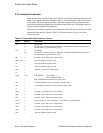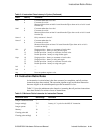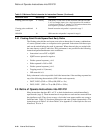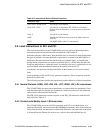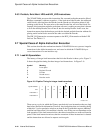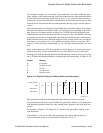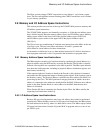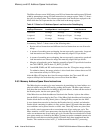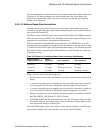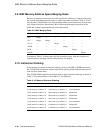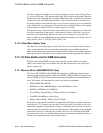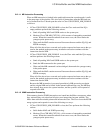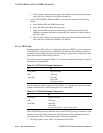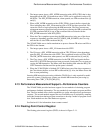
2–28 Internal Architecture
21264/EV68A Hardware Reference Manual
Memory and I/O Address Space Instructions
The Mbox allocates a new MAF entry to an I/O load instruction and increases I/O band-
width by attempting to merge I/O load instructions in a merge register. Table 2–7 shows
the rules for merging data. The columns represent the load instructions replayed to the
MAF while the rows represent the size of the load in the merge register.
In summary, Table 2–7 shows some of the following rules:
• Byte/word load instructions and different size load instructions are not allowed to
merge.
• A stream of ascending non-overlapping, but not necessarily consecutive, longword
load instructions are allowed to merge into naturally aligned 32-byte blocks.
• A stream of ascending non-overlapping, but not necessarily consecutive, quadword
load instructions are allowed to merge into naturally aligned 64-byte blocks.
• Merging of quadwords can be limited to naturally-aligned 32-byte blocks based on
the Cbox WRITE_ONCE chain 32_BYTE_IO field.
• Issued MB, WMB, and I/O load instructions close the I/O register merge window.
To minimize latency, the merge window is also closed when a timer detects no I/O
store instruction activity for 1024 cycles.
After the Mbox I/O register has closed its merge window, the Cbox sends I/O read
requests offchip in the order that they were received from the Mbox.
2.8.3 Memory Address Space Store Instructions
The Mbox begins execution of a store instruction by translating its virtual address to a
physical address using the DTB and by probing the Dcache. The Mbox puts informa-
tion about the store instruction, including its physical address, its data and the results of
the Dcache probe, into the store queue (SQ).
If the Mbox does not find the addressed location in the Dcache, it places the address
into the MAF for processing by the Cbox. If the Mbox finds the addressed location in a
Dcache block that is not dirty, then it places a ChangeToDirty request into the MAF.
A store instruction can write its data into the Dcache when it is retired, and when the
Dcache block containing its address is dirty and not shared. SQ entries that meet these
two conditions can be placed into the writable state. These SQ entries are placed into
the writable state in program order at a maximum rate of two entries per cycle. The
Mbox transfers writable store queue entry data from the SQ to the Dcache in program
order at a maximum rate of two entries per cycle. Dcache lines associated with writable
store queue entries are locked by the Mbox. System port probe commands cannot evict
these blocks until their associated writable SQ entries have been transferred into the
Dcache. This restriction assists in STx_C instruction and Dcache ECC processing.
Table 2–7 Rules for I/O Address Space Load Instruction Data Merging
Merge Register/
Replayed Instruction Load Byte/Word Load Longword Load Quadword
Byte/Word Nomerge Nomerge Nomerge
Longword No merge Merge up to 32 bytes No merge
Quadword Nomerge Nomerge Mergeupto64bytes



